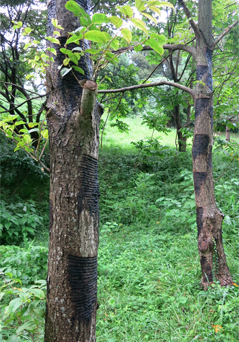The works by Hikoju Makie are created by Wakamiya, the group's leader, who draws up the blueprint of the works and determines what steps to take toward the final finish. Yet, he is not the one who do the job.
There are ten members in Hikoju Makie, and there are also many specialists-mostly specializing in woodcraft-with varied skills. Each process in the making of a piece is possible thanks to the time and efforts each one of these specialists dedicates themselves to. That is to say, their "Godly hands" shape the concepts of Wakamiya.

Lacquer, know as urushi in Japanese, is a natural materied obtained from the sap of the lacquer tree.
It will take about 15 years for the lacquer tree to mature and produce good quality urushi. From June to November, the sap is collected by making about 20 incision(cut) in to the bark of the tree. About 200g of urushi can be collected from one tree.
The quality of the urushi harvested is determined by the technical capabilities of urushi scraping.
The harvested tree will be cut down in that year, in order for some new shoot to grow from the root of the felled tree. In Japanese, this process is called “koroshi kaki”.